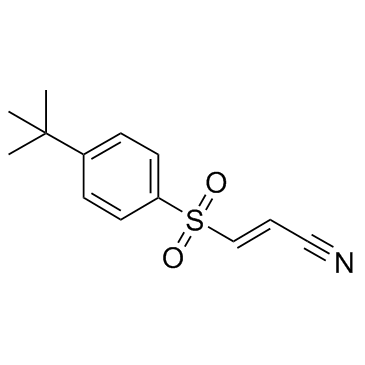Bay 11-7085

Bay 11-7085 structure
|
Common Name | Bay 11-7085 | ||
|---|---|---|---|---|
| CAS Number | 196309-76-9 | Molecular Weight | 249.329 | |
| Density | 1.1±0.1 g/cm3 | Boiling Point | 407.1±45.0 °C at 760 mmHg | |
| Molecular Formula | C13H15NO2S | Melting Point | 80-82℃ | |
| MSDS | Chinese USA | Flash Point | 200.0±28.7 °C | |
Use of Bay 11-7085BAY 11-7085 is an inhibitor of NF-κB activation and phosphorylation of IκBα; it stabilizes IκBα with an IC50 of 10 μM. |
| Name | (E)-3-(4-tert-butylphenyl)sulfonylprop-2-enenitrile |
|---|---|
| Synonym | More Synonyms |
| Description | BAY 11-7085 is an inhibitor of NF-κB activation and phosphorylation of IκBα; it stabilizes IκBα with an IC50 of 10 μM. |
|---|---|
| Related Catalog | |
| Target |
NF-κB IκB-α:10 μM (IC50) |
| In Vitro | BAY 11-7085 inhibits TNFa-induced surface expression of E-selectin, VCAM-1, and ICAM-1with IC50 values in the range of 5-10 μM. BAY 11-7085 stabilizes IκBα in a dose-dependent manner with an IC50 value of approximately 10 μM. There is a clear correlation between the concentration of drug that stabilized IκBα, the concentration that inhibits nuclear levels of NF-kB, and the concentration that inhibits adhesion molecule expression[1]. BAY 11-7085 has been shown to inhibit cell proliferation and induce apoptosis of a variety of cells. BAY 11-7085 (ECSCs) significantly inhibits the cell proliferation and DNA synthesis of ovarian endometriotic cyst stromal cells and induces apoptosis and the G0/G1 phase cell cycle arrest of these cells. BAY 11-7085 induces apoptosis of ECSCs by suppressing antiapoptotic proteins, and that caspase-3-, -8-, and -9-mediated cascades are involved in this mechanism[2]. |
| In Vivo | BAY 11-7085 acts as an anti-inflammatory agent in both the rat carrageenan paw and the rat adjuvant arthritis model. It demonstrates a dose-dependent reduction in swelling in the rat carrageenan paw model[1]. |
| Cell Assay | ECSCs cells are incubated for 48 h with BAY 11-7085 (0.01-10 μM). Thereafter, 20 μL of WST-1 dye are added to each well, and the cells are further incubated for 4 h. All experiments are performed in the presence of 10% FBS. Cell proliferation is evaluated by measuring absorbance at 540 nm[2]. |
| Animal Admin | Rats: 1% suspension of carrageenan in distilled water is administered to rats as 0.1 mL subplantar injection into the footpad of the right hind paw. One hour prior to injection, rats are treated intraperitoneally with vehicle (polyethylglycol 400 diluted 1:5 in 5% bovine serum albumin/water) or a fine suspension of compound 2 (1, 5, or 50 mg/kg) in vehicle. A positive control group is also included in which rats are pretreated with 20 mg/kg ibuprofen. Four hours after carrageenan administration, the volume of the injected paw is measured. Edema volumes are determined[1]. |
| References |
| Density | 1.1±0.1 g/cm3 |
|---|---|
| Boiling Point | 407.1±45.0 °C at 760 mmHg |
| Melting Point | 80-82℃ |
| Molecular Formula | C13H15NO2S |
| Molecular Weight | 249.329 |
| Flash Point | 200.0±28.7 °C |
| Exact Mass | 249.082352 |
| PSA | 66.31000 |
| LogP | 2.51 |
| Vapour Pressure | 0.0±0.9 mmHg at 25°C |
| Index of Refraction | 1.535 |
| Storage condition | Store at +4°C |
| Water Solubility | DMSO: >25 mg/mL, soluble |
| Personal Protective Equipment | Eyeshields;Gloves;type N95 (US);type P1 (EN143) respirator filter |
|---|---|
| RIDADR | NONH for all modes of transport |
| WGK Germany | 3 |
| RTECS | UD1312500 |
| HS Code | 29309090 |
|
Infection of human amniotic and endothelial cells by Japanese encephalitis virus: Increased expression of HLA-F.
Virology 471-473 , 29-37, (2015) Productive infection of human amniotic and endothelial cell lines with Japanese encephalitis virus (JEV) was established leading to the induction of NFκB and HLA-F, a non-classical MHC molecule. Induc... |
|
|
High-content positional biosensor screening assay for compounds to prevent or disrupt androgen receptor and transcriptional intermediary factor 2 protein-protein interactions.
Assay Drug Dev. Technol. 12(7) , 395-418, (2014) The androgen receptor-transcriptional intermediary factor 2 (AR-TIF2) positional protein-protein interaction (PPI) biosensor assay described herein combines physiologically relevant cell-based assays ... |
|
|
Vascular wall hypoxia promotes arterial thrombus formation via augmentation of vascular thrombogenicity.
Thromb. Haemost. 114 , 158-72, (2015) Atherosclerotic lesions represent a hypoxic milieu. However, the significance of this milieu in atherothrombosis has not been established. We aimed to assess the hypothesis that vascular wall hypoxia ... |
| 2-Propenenitrile, 3-[[4-(1,1-dimethylethyl)phenyl]sulfonyl]-, (2E)- |
| (2E)-3-[(4-tert-Butylphenyl)sulfonyl]acrylonitrile |
| (2E)-3-{[4-(2-Methyl-2-propanyl)phenyl]sulfonyl}acrylonitrile |
| Bay 11-7085 |
| (E)-3-(4-tert-butylphenylsulfonyl)acrylonitrile |
| (E)-3-(4-t-Butylphenylsulfonyl)-2-propenenitrile |

